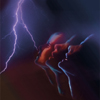 Whether paired with Taylor Richardson (Infinity Window) or solo (Oneohtrix Point Never), Daniel Lopatin rarely strays from the world of science fiction. Each synthesized note; each string of composition; each fractured note a piece of a world once brought to us by Carl Sagan and Leonard Nimoy. Zones Without People continues to explore the vast virginal openness that is space—and like the atmosphere he deftly reproduces in sound, Lopatin's boundaries are always contracting and expanding to create music for all beings of the universe.
Whether paired with Taylor Richardson (Infinity Window) or solo (Oneohtrix Point Never), Daniel Lopatin rarely strays from the world of science fiction. Each synthesized note; each string of composition; each fractured note a piece of a world once brought to us by Carl Sagan and Leonard Nimoy. Zones Without People continues to explore the vast virginal openness that is space—and like the atmosphere he deftly reproduces in sound, Lopatin's boundaries are always contracting and expanding to create music for all beings of the universe.The supposed sound of the future has been created since man's first encounters with the heavens and stars. From ancient civilizations to modern times, jacks of all trades have been plying their craft in hopes of capturing the essence of space. Somewhere in the Mid-20th Century, our infatuation with space exploration, the idea of unidentified objects, and the secrets of the cosmos began infiltrating all walks of life. Pop culture began to engulf the idea of space with the creation of hokey trinkets, pointless cross-promotions, and a campiness that by today's standards seems misguided. Whether it was Mel Torme singing about the moon and stars or The Jetsons creating a generation longing for flying, folding cars and housekeeping robots, the universe became the butt of a colossal joke.
After man landed on the moon and pride turned to nostalgia, a sea of musicians began to transform the swinging ideas of lounge acts and studio executives into darker expanses, viewing space their ebon-tinged prism only few dared to view. The synthesizer became the otherworldly tool to accomplish such feats but it quickly became another rotting piece of technology gone to waste by lazy dreamers. So imagine the surprise when the synth began making its long-awaited comeback in the bedrooms of musicians intrigued by Tangerine Dream and Ash Ra Tempel. These new creations weren't just looking to capture the grandiose feel of their 1970s influences but were also tapping into that 1950s fantasy of the future. Modern technology has allowed us to take those visions of our elder kin and breathe renewed life into them, which exactly why Oneohtrix Point Never's Zones Without People is a rousing success.
Zones Without People is the spastic cousin of Clint Mansell's soundtrack to the recent sci-fi film, Moon. Where Mansell built spatial melodies around isolation, Lopatin's synth-and-bleep collage bridges the emptiness of space with the fertile imagination of the science geek in all of us. Zones Without People is the sound of haywire robots ("Learning to Control Myself"), malfunctioning spacecrafts ("Format and Journey North"), and shooting stars ("Hyperdawn") all wrapped within the universe's infinite expansion. Rather than separate his 8-bit sound effects and his lush synth drones, Lopatin marries the two in perfect harmony. The mechanisms we've associated with space exploration thanks to countless films and documentaries are funneled through Lopatin's rich textures, producing the quintessential sci-fi album for anyone who adores how previous generations interpreted the music of the planets.
Daniel Lopatin does not shy away from the sounds of high school science films nor is he afraid of creating music with boundaries, which is why Zones Without People will continually amaze. Lopatin's latest puts a whole new spin on the cliché, "It's a grower"—as just in space, Zones Without People is ever-growing with the reverberations of one big bang.
samples:
Read More

